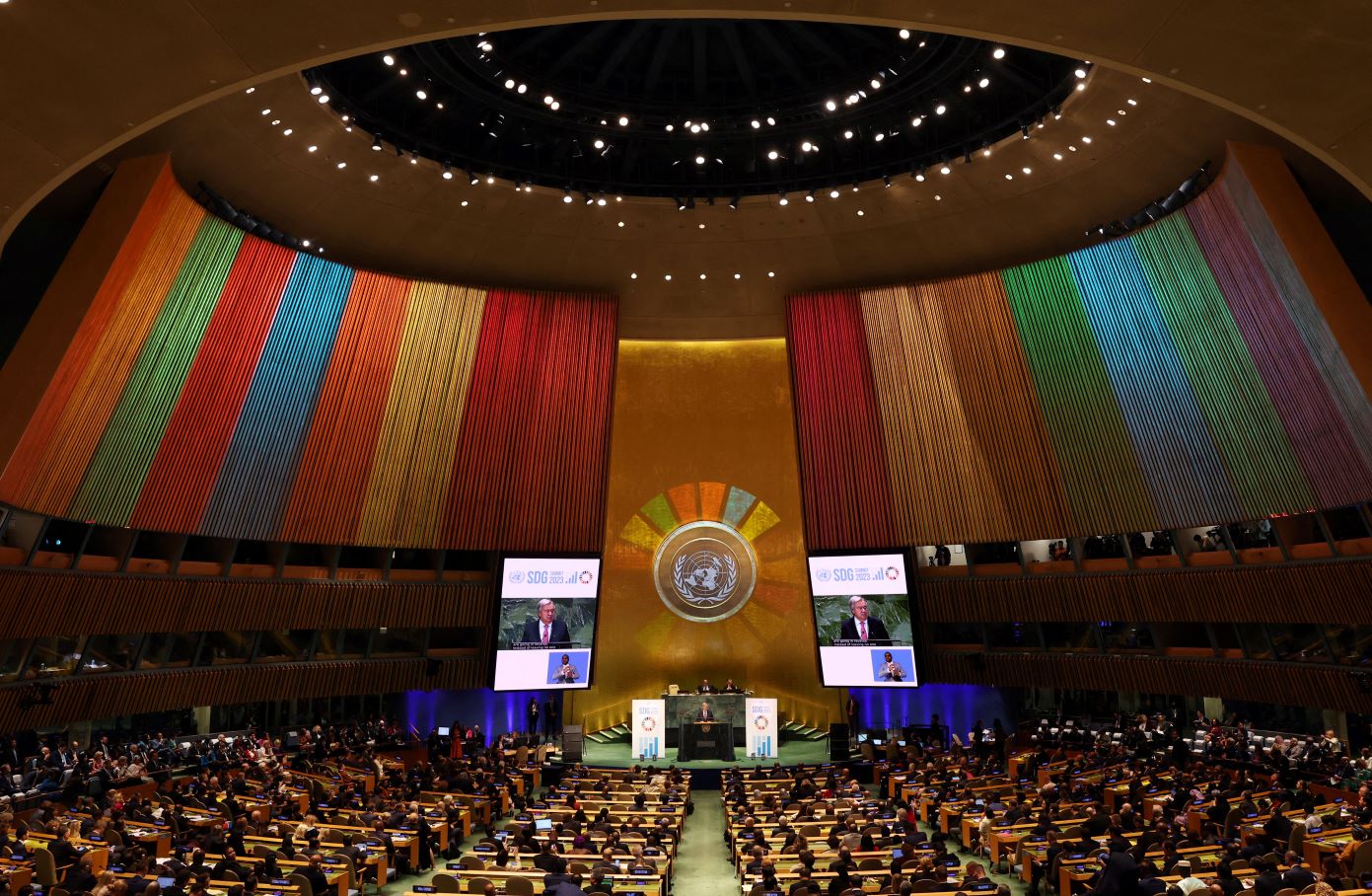World leaders unanimously adopted the 2030 Agenda for Sustainable Development in 2015, ambitiously aiming to speed economic prosperity and social wellbeing while protecting the environment. Unfortunately, the world is not on track to meet the seventeen Sustainable Development Goals (SDGs). The United Nations convened a high-level political forum on sustainable development on the sidelines of the UN General Assembly last month aiming to put the world back on track. Five Council of Councils experts reflect on the 2023 SDGs summit and discuss whether countries should prioritize a subset of specific SDGs going forward.

Should We Have Priorities Within SDG Priorities?
The United Nations’ latest update on progress toward meeting the SDGs paints a dire picture. Progress on more than 50 percent of targets is weak and insufficient and 30 percent have stalled or reversed. The reasons why are clear—the pandemic, the escalating effects of climate change, and Russia’s war on Ukraine.
At last month’s halfway summit, UN Secretary-General António Guterres called for a “Rescue Plan for People and Planet” to re-energize pursuit of the goals through an SDG stimulus and a reform of the international financial architecture. He achieved some support in the concluding high-level political declaration, but very little, if anything, in terms of concrete commitments.
So the inevitable question is whether the world might move forward faster and with greater chance of success by prioritizing a smaller number of SDGs within the seventeen and seeking to make them simpler.
The harsh reality is that some of the actions encapsulated within the SDGs—notably action to stabilize the climate or to prevent a future pandemic and control antimicrobial resistance—are needed now to prevent a human catastrophe on an unimaginable scale. Other actions will also save or greatly improve the quality of millions of lives, but, if delayed, would not jeopardize the future of mankind. Moreover, the total SDG financing gap, now estimated at $4 trillion per annum through 2030, a substantial part of which can only be met by public international finance from multilateral development banks and others, is, sadly, unlikely to be met in full any time soon.
It would certainly make no sense to try to renegotiate the SDGs themselves, given how much has already been invested in them and the difficulty today of reaching international agreement on anything, compared with 2015, a high point of multilateralism. But that leaves open the possibility of a more or less formal (and public) understanding that some goals will be prioritized over others.
The difficulty is that, despite the logic of prioritizing some goals over others, stepping back from the commitment made to the full package of seventeen would be seen as yet another example of the governments of the world making solemn promises that they are not prepared to keep. It could also underplay the real technical and political links between addressing existential threats and other steps to combat poverty.
The only practical way forward is a messy compromise, delivered through the negotiations over financing arrangements to tackle global challenges at the International Monetary Fund and World Bank annual meetings this week and beyond. This will likely enshrine some implicit trade-offs between the different SDGs. But at this stage, the top priority needs to be generating the largest possible increase in the amount of public and private finance, rather than consuming political energy in a public debate on whether some SDGs matter more than others.
Navigating the Complexities: Prioritizing the SDGs in a Changing World
The 2023 SDG summit, adopted a crucial political declaration, reaffirming the world’s commitment to the SDGs. The declaration assessed progress, acknowledged existing gaps and challenges, issued a call to action for steering the world toward the 2030 objectives and highlighted convergence on critical issues, including climate change, social protection, and the need to go beyond economic growth.
To be sure, the SDG framework needs to improve—as its normative and one-size-fits-all approach, along with issues in compatibility between targets and their monitoring, adds complexity. Policymakers encounter evident contradictions and trade-offs when pursuing these goals. For instance, pursuing economic growth in SDG8 might hinder progress on the climate action in SDG13, as industrialization introduces new pollutants contrary to environmental goals.
These trade-offs are more pronounced in developing regions, which face significant constraints in financing the SDGs. Hence, this complex landscape necessitates a thoughtful approach to prioritize specific goals that align with each country's unique circumstances and challenges through a five-point agenda.
1. Tailored Approaches: Countries should prioritize a subset of SDGs based on national priorities, capacities, and immediate needs. Adopting a tailored approach allows nations to focus their resources and efforts on goals most relevant and achievable within their socio-economic context.
2. Leveraging Data: Data collection and monitoring are crucial to track the SDGs to provide the necessary information to evaluate progress, identify challenges, and make informed decisions. They enable countries to identify priority areas where they are lagging or facing challenges and are essential for governments to allocate resources effectively and address the most pressing issues.
3. Strategic Focus: Prioritization does not imply neglecting other goals, but instead strategically concentrating efforts where a country can make the most significant impact. This approach acknowledges the interconnectedness of the SDGs while recognizing the practical constraints that countries face.
4. Adaptable Strategies: The dynamic nature of global challenges requires flexible strategies. Countries may need to periodically reassess their priorities based on evolving circumstances and emerging issues. This flexibility ensures a responsive and practical approach to sustainable development.
5. Global Cooperation: While countries prioritize specific SDGs, international cooperation remains paramount. Collaboration and information sharing enable nations to learn from each other's successes and challenges, fostering a collective effort towards achieving the overarching vision of sustainable development.
Prioritizing SDGs is a strategic necessity, especially when the current trajectory indicates the world is not on track to achieve all seventeen goals. A targeted and context-specific approach ensures that efforts are concentrated where they are most needed and can significantly advance sustainable development.
The SDGs Should Remain People-Centered
Today’s world is vastly different from when the SDGs were adopted in 2015. The year’s global unity, diversity, and shared aspirations embodied the spirit of the SDGs, with the seventeen goals serving as the guiding light that all nations, for the first time in history, unanimously agreed on.
Consequently, all countries embarked on the journey to pursue most of their goals, taking into account the three dimensions of the SDGs: economic, social, and environmental. Since then, most countries have made substantial efforts to adapt the goals to their specific contexts, capacities, and levels of development, while respecting their policies and national priorities. Now, this endeavor is more critical than ever.
Latin American and Caribbean countries encounter numerous challenges in implementing the SDGs, which is why it is crucial to focus on the fundamental principles that underpin them. People should remain at the center of the SDGs, particularly given Latin America and the Caribbean are among the most unequal and most violent regions in the world. Therefore, it is imperative to invest in education and early childhood development.
The SDGs milestones should continue to center around nurturing human development and incorporating the agenda into a life cycle perspective. Prioritizing investments in early childhood is pivotal in this regard. The cost of inaction is substantial in terms of missed opportunities. Inadequate nutrition, care, and stimulation hinder individual and social potential and affect all three dimensions of the SDGs. Education, especially early childhood interventions, has proven to be the most cost-effective approach. It not only contributes to the attainment of several goals but also has a multiplier effect on future SDG outcomes. The connection between early childhood development and equity, productivity, and sustainable growth is indisputable.
To achieve this, national governments and the United Nations should more urgently seek financial cooperation. Due to economic recessions in several countries in Latin American and the Caribbean, securing new resources to promote human development in the early stages of life is essential for the implementation of all of the SDGs.
With this context in mind, it is imperative to strengthen global alliances for sustainable development, mobilize international financial resources, and promote the involvement of the private sector and civil society through tangible initiatives, especially in areas where investment is most needed.
The Interconnected Nature of the SDGs: Why They Should Be Addressed Together
The SDG summit marked the halfway point of the 2030 Agenda. It is evident that the world is not on track to achieve many of the SDGs by 2030. In the face of limited financial resources, the question arises: should certain SDGs be prioritized over others? The answer, despite the challenges of mobilizing resources, mounting geopolitical tensions, and the short timeframe, is a resounding no. De-prioritizing some of the SDGs is not a viable solution and could even backfire, due to the interconnected nature of these goals, and national governments and the United Nations should address them together.
The International Science Council pointed this out in their Guide to SDG Interactions: From Science to Implementation, and called for a science-informed analysis of interactions across SDG domains to enable coherent and effective policymaking. Many of the SDGs are inextricably linked through shared drivers and consequences, and understanding the possible trade-offs, as well as synergistic relations between the different SDG targets, is crucial for achieving long-lasting sustainable development outcomes.
The SDGs are not standalone goals or agendas; they are a comprehensive package, more of a web of targets than a list, and their success is deeply intertwined. Attempting to prioritize one goal over another would undermine the very essence of sustainable development. Consider the relationship between ending poverty in all its forms everywhere (SDG1), ensuring inclusive and equitable quality education (SDG4), and achieving gender equality (SDG5). Poverty often prevents children, especially girls, from accessing education, perpetuating a cycle of deprivation. Thus, efforts to eradicate poverty must go hand in hand with improving education opportunities and gender equality. Climate change, for instance, demands action on multiple fronts, from transitioning to clean energy (SDG7) to conserving ecosystems (SDG14 and SDG15) to building the adaptive capacity of communities already impacted (SDG13).
Going forward, rather than focusing on a select few SDGs, a more effective approach is to seek solutions that create synergies between the different targets. This entails recognizing that progress in one area can catalyze advancements in others. For example, the catalytic role of digital innovations for all seventeen SDGs was highlighted by the SDG Digital initiative. Furthermore, an inclusive circular economy, a systems change model for maximizing the value of resources, and a new paradigm for industrialization and technological innovation, can stimulate not only progress on ensuring sustainable consumption and production (SDG12), but also multiple other SDGs.
By embracing systematic approaches, we can tap into the transformative power of the SDGs. Sustainable development is not just about solving individual problems; it's about reshaping our societies and economies to be more equitable, inclusive, secure, and environmentally sustainable. This transformative potential can only be realized by addressing the interconnectedness of the SDGs.
Addressing Undernourishment and Climate Change Adaptation in Agriculture
The political declaration of the 2023 SDGs summit showed a strong sense of policy continuity in still seeking to meet the SDGs within the 2030 timeline, despite its bold admission that there has been slow progress and, at times, regression in these targets even below the 2015 levels. The disappointing progress in the SDGs despite continuity at the global level hints at the need for systemic changes at the local and regional levels if the SDGs are to be met on time.
While the summit cited that much has changed since 2019, given the COVID-19 pandemic, the growing burdens resulting from the pandemic only add to the continuing systemic challenges from climate change even before the pandemic erupted. This has important implications especially for addressing undernourishment in SDG2, and climate adaptation and greenhouse gas emissions reduction in SDG13.
The red light for SDG2 started blinking as early as 2018, when a UN Food and Agriculture Organization report showed a reversal in progress toward addressing undernourishment globally. Whereas the number of undernourished declined from 945 million people in 2005 to 783.7 million in 2014, this has since increased to an estimated 820 million by 2017. Such a reversal resonates at the regional and sub-regional levels, too. Southeast Asia saw undernourishment fall from 101.7 million in 2005 to 60.5 million in 2014, but increased for the first time to 63.5 million by 2016.
Agriculture has long suffered from the harmful effects of climate change, including a reduction in farm productivity, leading to less progress in addressing undernourishment. But the bigger issue is that society today is facing a wicked problem given trade-offs between meeting the growing demand for food supplies to meet future consumption requirements in SDG2, and reducing greenhouse gas emissions under SDG13. Given land constraints, farm production will need to intensify; yet, such growth, and agriculture in general, contribute significantly to emissions.
The UN General Assembly’s future approaches to the SDGs should therefore be tailored toward engaging the policy and scientific community, academia, farmers, and the private sector, to finding solutions to such wicked problems as growing more food with fewer emissions. These can potentially foster the drastically needed systemic changes to put the world back on track amid worrying SDGs trajectories.











